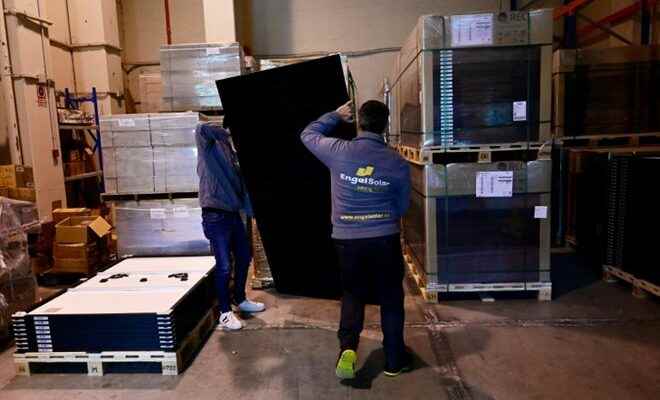Employees of the Engel Solar company install solar panels on the roof of a house on December 21, 2022 in Boadilla del Monte, near Madrid (AFP/JAVIER SORIANO)
Excavations and demand “never seen”: in Spain, individual photovoltaic installations are booming, boosted by soaring energy prices. The opportunity for the country to catch up in a sector with high potential.
“The sun here, we have it almost all year round,” recalls Paloma Utrera, presenting the black panels installed on the roof of her pavilion in Pozuelo de Alarcón, a well-to-do town in the suburbs of Madrid. “You have to take advantage of it,” she adds, all smiles.
Like many Spaniards in recent months, this employee in the airline sector launched at the end of September into “self-consumption”, which consists of producing one’s own electricity, by having 13 photovoltaic panels installed in her home with a total power of 4.5 kilowatts.

Paloma Utrera in front of her house where she had solar panels installed on the roof, on December 19, 2022 in Pozuelo de Alarcon, near Madrid (AFP / JAVIER SORIANO)
“It’s a significant investment” but “with the aid” offered by the State and “the savings” made on its electricity consumption, “it’s really worth it”, judges this 50-year-old woman, who specifies cut his bills in half since the fall.
According to the company that carried out the installation, Engel Solar, the solar panels provide “between 50 and 80%” of a household’s needs.
“Given the current prices of electricity”, it is “interesting”, underlines the commercial director of this SME of 200 employees, Joaquín Gasca.

Joaquín Gasca, commercial director of EngelSolar, in the company’s warehouses, on December 19, 2022 in Madrid (AFP / JAVIER SORIANO)
Founded in 2005 in Barcelona, this company has multiplied its turnover by five in two years, and expects a new jump in activity in 2023.
“The phone keeps ringing, it’s madness,” says Joaquín Gasca, evoking a “spectacular” dynamic.
– “The bank” or “the roof” –
Individuals, professionals, public institutions… Boosted by the energy crisis linked to the war in Ukraine, but also by aid from the European recovery plan, self-consumption has never experienced such enthusiasm in the country.

An employee of the Engel Solar company delivers a solar panel on December 21, 2022 in Boadilla del Monte, near Madrid (AFP / JAVIER SORIANO)
“A year ago, when we looked at the roofs in Spanish towns and villages, we saw very few solar panels”, but “today the situation has completely changed”, summarizes Francisco Valverde, specialist in renewable energies at within the firm Menta Energia.
A finding shared by José Donoso, Secretary General of the Spanish Photovoltaic Union (UNEF). The Spaniards “see that their neighbors are embarking on self-consumption, that they are happy and that they are saving money. This encourages them to do the same”, he explains.
According to this federation, which brings together 780 companies in the photovoltaic sector, the “installed power” in self-consumption in 2022 should exceed 2,000 megawatts, almost double that of 2021 (1,203 MW) and four times that of 2020 (596 MW).
Solar energy has become “very competitive”, with a cost “now 90% lower than 14 years ago”, says José Donoso. People have therefore “understood that it is better to put their money on their roof than in the bank”, he laughs.
– “Democratizing energy” –
For the sector, this frenzy has a taste of revenge. The sunniest country in Europe, Spain was one of the world leaders in photovoltaics 15 years ago. But the 2008 crisis put a brake on this growth and Madrid fell behind many European countries.

Employees of the Engel Solar company install solar panels on the roof of a house on December 21, 2022 in Boadilla del Monte, near Madrid (AFP/JAVIER SORIANO)
At issue: the end of subsidies to the sector, then the establishment in 2015 by the former Conservative government of a tax for households producing electricity and returning part of this energy to the national grid, described as ” tax on the sun” by its detractors.
This system – set up, according to environmentalists, under pressure from large energy groups, worried about competition from self-consumption – was abandoned after the left came to power in 2018, which has since multiplied the boosts to the sector.
Self-consumption “democratizes energy” and makes it possible to emancipate oneself “from the large energy groups”, justified socialist Prime Minister Pedro Sanchez at the end of October, who expects 39,000 megawatts of new photovoltaic capacities by 2030, including 9 at 14,000 in self-consumption.

EngelSolar employees handle a solar panel in the company’s warehouses on December 19, 2022 in Madrid (AFP/JAVIER SORIANO)
Enough to boost this source of energy which supplied 9.9% of Spanish electricity last year, far behind wind power (23.3%), nuclear power (20.8%) and gas-fired power plants (17.1%)… despite a potential deemed exceptional.
Today, “only 4 to 5% of (Spanish) homes are equipped with photovoltaics. The margin for progress is therefore enormous”, underlines Joaquín Gasca, who says he expects to see photovoltaics become “the first source of energy ” in the country.
© 2022 AFP
Did you like this article ? Share it with your friends with the buttons below.




